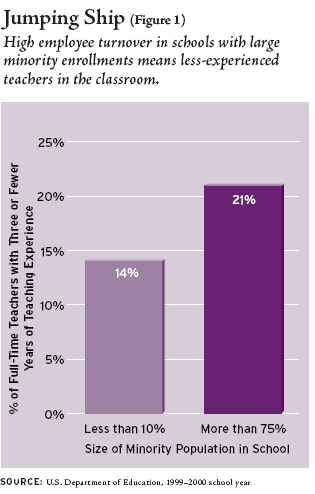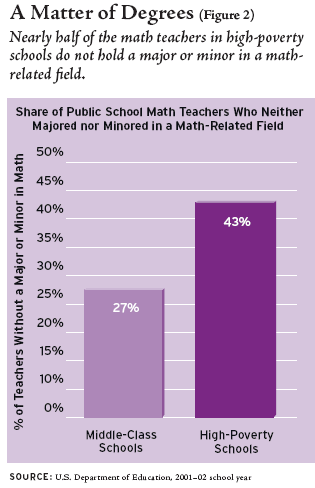 |
| Disadvantaged schools need better teachers. Here’s how to attract and retain them.
|
If there is one lesson I learned before being elected governor of Virginia in 2001, it is that the most important asset of any enterprise is the talent and enthusiasm of its workforce. In operating a successful business, there is no greater challenge than to attract and retain the best-qualified, hardest-working employees.
To accomplish this, businesses must offer competitive compensation and benefit packages, positive working environments, and opportunities for employees to gain more responsibility and to upgrade their skills.
However, perhaps the most important factors in keeping the best people are providing workers with the tools to succeed at what they do and ensuring that they feel a sense of respect and empowerment about their work. Businesses that fail to offer these things will lose their brightest employees to competitors that do.
Having learned these lessons firsthand as a business owner, I am determined as a governor to apply them to the single greatest challenge facing our public schools today–the challenge of providing the best possible teachers to students in our lowest-achieving schools.
Learning from Success
Teachers are by far the most important factor in a school’s success. On this point the research is clear. For instance, a 1991 study conducted in Texas found that the quality of a school’s teachers exerted the single greatest influence on achievement outside of students’ family background. A 1996 study conducted in Tennessee found that students who had three good teachers in a row improved their performance markedly. By contrast, those who had the misfortune to be placed in classrooms with three bad teachers in a row saw their achievement levels plummet. In a review of the research literature, University of Washington scholar Dan Goldhaber concluded, “It appears that the most important thing a school can do is to provide its students with good teachers” (see “The Mystery of Good Teaching” in the Spring 2002 issue).
In designing policies aimed at attracting and retaining the good teachers, what policymakers must not forget is that teachers are no different from employees in the private sector. They want to succeed in their jobs and they demand the tools, the respect, and the sense of empowerment necessary to reach this goal. If a school does not provide these elements, the best teachers will find one that does.
In this regard, it is important to recognize that among teachers, money is not always the main concern in deciding where to teach. In a Public Agenda survey, more than 85 percent of teachers indicated that they would choose a school with well-behaved students and supportive parents over one where they would earn a significantly higher salary.
Unfortunately, schools serving low-income and minority students are often at a competitive disadvantage in trying to meet their employees’ needs. For instance, just 35 percent of teachers in schools with large minority student populations say their school is “very good” when it comes to having a safe and respectful atmosphere, compared with 68 percent of teachers in schools with few minority students.
The result is that children who attend high-poverty and/or high-minority schools are:
• More likely than other children to be taught by an inexperienced teacher (see Figure 1);
• More likely to be taught by teachers who were low achievers in college;
• More likely–in every single subject area–to be taught by teachers who did not major or even minor in the subjects they are teaching (see Figure 2);
• Considerably less likely to be taught by a fully certified teacher;
• Far more likely to be in a school that suffers from extremely high rates (30 to 50 percent a year) of teacher turnover.

The consequences–scandalously low achievement levels and high dropout rates among disadvantaged youth–are well known. But what can be done?
To begin, we must learn from success. Organizations such as the Education Trust have identified hundreds of schools across the country where disadvantaged kids routinely buck the trend of underperformance. For instance, the student body at Samuel W. Tucker Elementary in Alexandria, Virginia, is 68 percent minority and 53 percent low income. Yet in 2002 the school outperformed 92 percent of all elementary schools in Virginia in reading and 86 percent of all elementary schools in math. Likewise, the 7th and 8th graders at Hambrick Middle School in Aldine, Texas, have placed in the top fifth of all Texas middle schools in reading and math over a three-year period, despite being 94 percent minority and 85 percent low income.
The key question for policymakers is therefore not whether it is possible to bring dramatic improvement to hard-to-staff schools. The question is how to learn from the existing success stories and from effective private-sector employment practices, and how to bring these lessons to scale for schools across the country.

Creating Innovative Policies
Shortages of qualified teachers in subjects like math, science, special education, and foreign languages, along with the impending retirements of an entire generation of teachers, make recruiting teachers to hard-to-staff schools even more challenging. Improving salaries is one important option, but many states still have fiscal problems that prevent them from approving costly new expenditures.
The real opportunity lies in improving the working conditions in hard-to-staff schools. This strategy includes several key elements:
• Reward teachers for higher performance. In my state, as in virtually all other states, teachers can earn more money in one of only a few ways: by accumulating college credits (even when those credits have nothing to do with what they are teaching); by accumulating more years of experience (even if that experience doesn’t make them any better); or by transferring to a more affluent school district that pays higher salaries. All of the existing incentives, therefore, run counter to any effort to reward good teaching and get good teachers where we most need them.
We need to significantly modify the current incentive structure. Like professionals in other fields, teachers ought to be rewarded for achieving results–in this case, based on their effectiveness in producing student learning. They ought to be paid more for taking on our most important challenges. And they ought to be able to increase their salary by maximizing both their impact and their level of challenge. A salary structure modified along these lines would place the emphasis where it belongs–on rewarding our most effective, hardest-working teachers.
There are isolated examples of school districts that reward teachers for high performance. In March 2004, the Denver Classroom Teachers Association approved a plan that would replace the current lockstep salary structure with a new salary schedule that rewards teachers who advance their teaching knowledge and skills in the subjects they teach, take on additional professional responsibilities, take on the toughest school assignments, and produce results. Other districts and states should consider advancing similar or even stronger pay-for-performance salary systems.
• Improve mentoring programs for new teachers. As with any employee given a challenging job in the business world, new teachers need to be given the proper tools to succeed. High-quality mentoring from master teachers is one such tool. In a recently published study for the Education Commission of the States, University of Pennsylvania scholar Richard Ingersoll reviewed the research literature and found that mentoring programs have shown a positive impact on teachers and their retention.
Mentoring programs are also cost-effective, which should make them even more appealing to states struggling with fiscal problems. According to the National Governors Association’s Center for Best Practices, new teachers who participated in a structured mentoring program in California had a 9 percent attrition rate over five years, compared with 37 percent attrition among those who did not participate. Since the cost of replacing a teacher is estimated at 30 percent of salary and benefits, a high-quality mentoring program offers a far less expensive alternative.
That is why a mentoring program targeted at hard-to-staff schools should be an integral part of any state policymaking agenda. In Virginia we are implementing a mentoring program with a record of success. The program will be based on the “Great Beginnings” model that has proven effective in Fairfax County, Virginia, and the Educational Testing Service’s “Pathwise” professional development program, which was piloted in Newport News, Virginia. Our Teacher Retention initiative will fund mentoring programs for new teachers in hard-to-staff schools during their first year in the classroom to: 1) encourage them to remain teachers and to stay in their current schools; and 2) prepare them to cope with the stumbling blocks they will likely face. The mentoring will be led by other, more experienced teachers in the school. Through annual reporting, participating districts will be required to show that their mentoring programs for new teachers have proved successful in increasing teacher retention.
• Tap proven leaders to turn around troubled schools. There is no substitute for effective leadership in establishing a positive environment for employees. Policymakers therefore need to take a much closer look at how to support and reward those principals and superintendents who help turn around hard-to-staff schools. In the business world, experts called “turnaround specialists” are now frequently used. These individuals are paid to turn struggling companies into positive performers.
The business world knows what kinds of leadership skills it takes to become such an expert. We have examples of turnaround specialists in the education world, too. But more work is needed to create a cadre of leaders who can enter hard-to-staff schools and bring about the necessary changes. We need to identify people who have the skills and experience, give them added training, and send them into challenged schools. These turnaround principals should have a proven record of overcoming adversity in schools.
In Virginia, I have established a training program for up to ten school administrators in the first year and an additional ten the following year. The University Partnership for Leaders in Education, a collaboration of the Darden Graduate School of Business Administration and the Curry School of Education at the University of Virginia, is selecting and training the first group. These individuals, who are being identified now, must be licensed or eligible for licensure as a school administrator in Virginia. They must have served in a leadership capacity in an educational, professional, or business environment for a minimum of five years and have demonstrated experience in providing successful leadership in a low-performing school or organization. The training will result in a “Turnaround Specialist” credential. Each specialist will serve as the principal of a low-performing school for a minimum of three years.
Training will focus on business and education strategies that have been effective in improving low-performing organizations. It will use proven business management strategies such as effective organizational management, finance and accounting practices, restructuring and renewal of troubled organizations, turnaround and crisis management, and lessons in business and education law. The University of Virginia’s business and education schools will develop the curriculum and provide the training for these turnaround specialists.
These specialists will work under a contract with the local school system that defines their responsibilities, goals, and measures of success. They may also negotiate to have additional authority beyond that of a regular school principal. In addition to the benefit of the intensive training, specialists will be eligible for incentives such as additional retirement benefits or deferred compensation.
• Make sure existing policies are equitable for hard-to-staff schools. State policies often have provisions that contribute to the problem of unequal teacher quality among schools. For example, many of the middle-school teachers who hold only elementary multiple-subject licenses do not have sufficient depth of knowledge in the content areas they teach. Currently, however, many states have adopted licensure policies that define the problem away by claiming that all of their current teachers, regardless of preparation, are highly qualified under federal guidelines if they have been teaching more than a year. To take better advantage of the new federal dollars that are available to help teachers become highly qualified, state policymakers should consider adopting more rigorous policies, such as requiring
middle-school teachers to hold a degree or pass an exam in the subjects they teach.
State policymakers should also examine policies that allow school districts to exclude teacher salaries from the calculations they must make to show that they provide an “equal” education to students at high- and low-poverty schools. In fact, many of these districts even “bill” their high-poverty schools for the average teacher salary instead of the actual (and usually much lower) salaries they are paying to their often brand-new, less-qualified teachers. This has the effect of draining substantial resources from the very schools that need the most and sending them instead to the schools that typically need the least.
• Engage parents and community leaders. Perhaps the best way to make hard-to-staff schools more attractive to teachers is to encourage stronger support from and connections to the surrounding community. This can provide teachers with the feeling that they are not alone or embattled in the work that they do.
In Virginia, I established a Partnership for Achieving Successful Schools (PASS) initiative, now in its second year. The PASS program has been deployed in 34 schools that have failed to meet Virginia’s rigid standards. Schools participating in the initiative agree to accept the assistance of teams of educators from demographically similar schools that have high levels of achievement in reading and mathematics.
In addition, PASS schools are paired with business and community-based partners that provide a variety of tutoring and other volunteer services and support. To date, close to 200 business and community partners have signed on to participate. For instance, IBM recently became a lead partner and will donate computers, printers, software, and employee and retiree volunteers to 11 underperforming schools. The involvement of prominent community players such as IBM, Verizon, and others sends a clear message to teachers, students, and parents that their schools matter and that the community at large cares how they perform.
The impact of this message can be impressive. Achievement in English has increased in 81 percent of the PASS schools designated as “high priority”; math achievement has improved in 91 percent of those schools. One of our middle schools went from being “accredited with warning” in math for two consecutive years to earning Virginia’s second-highest accreditation rating and achieving a 100 percent math passage rate.
There are, of course, strategies beyond those outlined here that states should consider in trying to help hard-to-staff schools attract and retain effective teachers. For instance, improving the care and education of children before they start school is of critical importance. Children in disadvantaged schools must be as healthy and ready to learn as those in more affluent communities. And we need innovative strategies to encourage teacher-preparation programs to focus more energy on training teachers specifically for work in at-risk schools.
In the end, policymakers need to keep in mind the simple truth that, just like other professionals, teachers want to succeed at the job they set out to do. And, as in other professions, the best and brightest will often gravitate to where they are respected, appreciated, and empowered to do their jobs effectively.
Mark R. Warner (D) is governor of Virginia and chairman of the Education Commission of the States.


